Kombu Seaweed, Indispensable to Japanese Cuisine
In Japan, people use kombu seaweed in everything, from daily meals to recipes for special occasions. You can use kombu in just about any way you like, but basically, there are two ways to prepare it-you can either make soup broth from it to use in your recipe,or you can use the kombu itself as an ingredient.
Making Kombu Broth, "Dashi"
First, let your kombu kelp sit in a bowl of water. After a while, kombu kelp extract which has a savory flavor will start to seep out, turning the water into Dashi (broth). The broth made from kombu kelp is the foundation of Japanese seasoning and is used in a host of Japanese dishes.
| Sushi |
Miso soup |
Japanese Nabe |
Udon, Soba Noodles |
 |
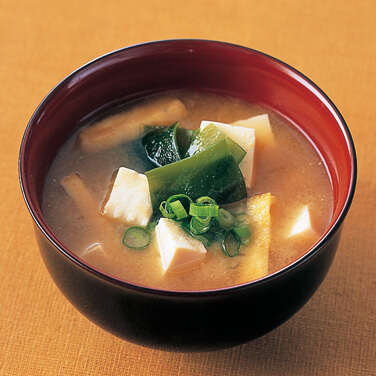 |
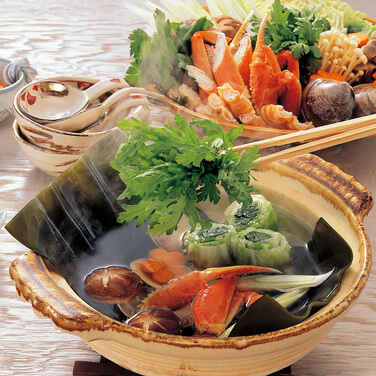 |
 |
| Sushi is perhaps the most well-known among Japanese cuisines. But it is a little-known fact that kombu kelp is used to season the rice in sushi. By cooking the rice for sushi together with kombu kelp, the Umami flavor from the kombu kelp gives it a totally delightful flavor. |
Miso soup is the most frequently eaten soup in Japan. This soup is made by adding miso, wakame (a type of seaweed), and tofu to broth made from kombu kelp and dried bonito flakes. The kombu kelp broth goes very well with miso soup and adds depth of flavor. It's the kind of soup that you would like to have everyday. |
Japanese nabe is a standard fixture during winter in Japan, absolutely indispensible during the cold season. Add kombu kelp to a pot of water to make broth, add tofu, vegetables, meats, and fish of your choice; serve with ponzu or sesame sauce. The Umami from the kombu kelp broth seeps into the ingredients, enhancing the natural taste. |
Udon is a well-known type of Japanese noodle. Boil udon and add it to a kombu kelp/bonito broth seasoned with soy sauce; serve with sliced kombu kelp and your favorite vegetables. The savory broth is full of Umami from the kombu kelp. |
Sushi

Sushi is perhaps the most well-known among Japanese cuisines. But it is a little-known fact that kombu kelp is used to season the rice in sushi. By cooking the rice for sushi together with kombu kelp, the Umami flavor from the kombu kelp gives it a totally delightful flavor.
Miso Soup

Miso soup is the most frequently eaten soup in Japan. This soup is made by adding miso, wakame (a type of seaweed), and tofu to broth made from kombu kelp and dried bonito flakes. The kombu kelp broth goes very well with miso soup and adds depth of flavor. It's the kind of soup that you would like to have everyday.
Japanese Nabe

Japanese nabe is a standard fixture during winter in Japan, absolutely indispensible during the cold season. Add kombu kelp to a pot of water to make broth, add tofu, vegetables, meats, and fish of your choice; serve with ponzu or sesame sauce. The Umami from the kombu kelp broth seeps into the ingredients, enhancing the natural taste.
Udon, Soba Noodles

Udon is a well-known type of Japanese noodle. Boil udon and add it to a kombu kelp/bonito broth seasoned with soy sauce; serve with sliced kombu kelp and your favorite vegetables. The savory broth is full of Umami from the kombu kelp.
Use as an Ingredient
Kombu broth is delicious, but that's not the only way to enjoy kombu kelp. You can also enjoy the kombu kelp itself, which is rich in nutrients. Kombu’s savory flavor is at the very heart of several great Japanese dishes.
Onigiri
(Rice Ball) |
Nimono
(Simmerd Dish) |
Kombu-maki
(tangle rolls) |
Ochazuke
(Rice with tea) |
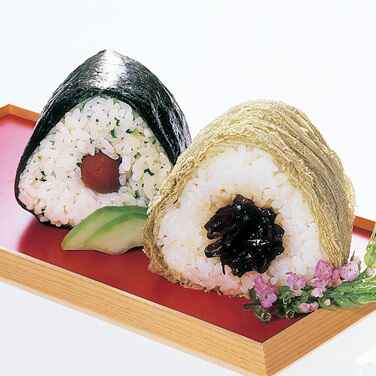 |
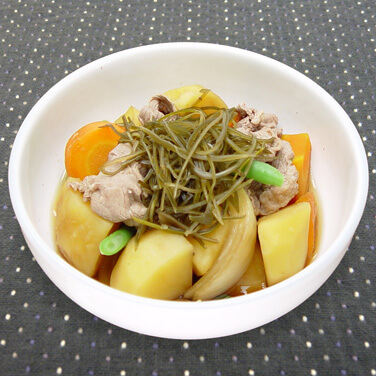 |
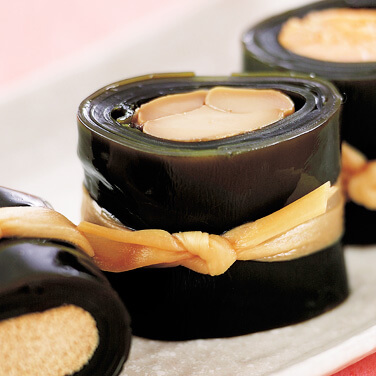 |
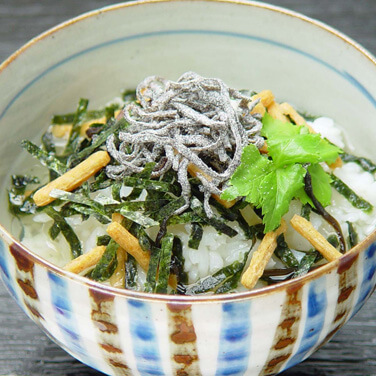 |
| Onigiri (rice ball) is popular in lunch bags. Onigiri is made by forming rice into circular or triangular shapes by hand. Put tsukudani-kombu or pickled plum inside the rice, or cover the rice with tororo-kombu (tangle flakes). |
Nimono is a collective term for stews boiled in broth or water with seasonings that bring out the flavors of the ingredients. Ingredients can include dried foods, fish, meats, beans or tofu, and vegetables. Kombu is essential to nimono, because the taste is enhanced by cooking it together with kombu kelp. The kombu kelp itself has a nice, chewy texture and is also delightful by itself. |
Kombu is believed to bring good luck and longevity and is widely used on special occasions. One such special dish is kombu-maki (tangle rolls). Gourd strips are used to tie the cut and rolled kombu kelp and seasoned with soy sauce. Kombu-maki also may contain salmon or herring. The Umami of the kombu kelp and gourd strips seep into the ingredients within, making it a perfect dish for celebrations. |
This is a dish where shio-kombu (kombu kelp boiled with soy sauce) is added to a bowl of rice, over which tea or hot water is poured. It is a very simple dish that many households enjoy. It is full of flavor, and people can enjoy both the kombu kelp broth and the kombu kelp itself together. |
Onigiri
(Rice Ball)

Onigiri (rice ball) is popular in lunch bags. Onigiri is made by forming rice into circular or triangular shapes by hand. Put tsukudani-kombu or pickled plum inside the rice, or cover the rice with tororo-kombu (tangle flakes).
Nimono
(Simmerd Dish)

Nimono is a collective term for stews boiled in broth or water with seasonings that bring out the flavors of the ingredients. Ingredients can include dried foods, fish, meats, beans or tofu, and vegetables. Kombu is essential to nimono, because the taste is enhanced by cooking it together with kombu kelp. The kombu kelp itself has a nice, chewy texture and is also delightful by itself.
Kombu-maki
(tangle rolls)

Kombu is believed to bring good luck and longevity and is widely used on special occasions. One such special dish is kombu-maki (tangle rolls). Gourd strips are used to tie the cut and rolled kombu kelp and seasoned with soy sauce. Kombu-maki also may contain salmon or herring. The Umami of the kombu kelp and gourd strips seep into the ingredients within, making it a perfect dish for celebrations.
Ochazuke
(Rice with tea)

This is a dish where shio-kombu (kombu kelp boiled with soy sauce) is added to a bowl of rice, over which tea or hot water is poured. It is a very simple dish that many households enjoy. It is full of flavor, and people can enjoy both the kombu kelp broth and the kombu kelp itself together.
Seaweed Encyclopedia
- Kombu -
contents








